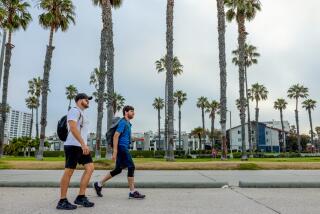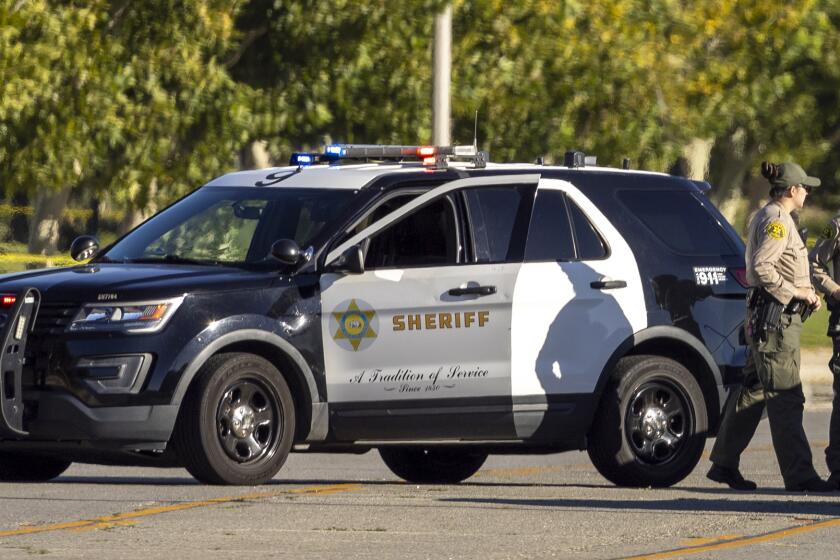Cal State Fullerton Professors Heading Study of Fitness Among the Elderly
- Share via
HUNTINGTON BEACH — A journey of a thousand miles must begin with a single step, as the saying goes. That applies to journeys of knowledge as well.
Ann Anderson’s journey began at 11:22 a.m. Thursday, when she stood up from a chair at Pacifica Hospital, walked around a red traffic cone taped to the carpeted floor and returned to her chair. Total distance: 8 feet. Total time: 12 seconds. Her age: 89.
“I like to keep active,” said Anderson, who lives in Huntington Beach’s Five Points Seniors complex. “If you sit down too much, you don’t want to get up.”
Anderson’s trek was part of a yearlong national study that backers say is the first attempt to measure the physical abilities of the elderly. The goal is to help establish guidelines for levels of strength and agility that the elderly must maintain to extend and improve the quality of their lives.
The study, directed by two Cal State Fullerton professors under a $300,000 grant from the PacifiCare/Secure Horizons managed-health organization, will test about 5,000 people over 60 in strength, endurance and flexibility.
The researchers hope ultimately to reduce levels of frailty among the elderly.
“We want to know what’s normal for people at different ages,” said Roberta Rikli, a professor of kinesiology at Cal State Fullerton. “It will give us some norms in five-year age increments, from 60 to 95, so we know what’s normal and what’s possible. Part of the study will also tell us how much strength is needed in order to be able to do what you need to do.”
Rikli said no such studies have been conducted before for a variety of reasons, including societal focus on youth--national standards exist for school-age physical performance--and a perceived lack of need.
In past generations, she said, daily living provided a certain amount of exercise. But labor-saving devices and conveniences have changed society, and increasing numbers of the elderly have prompted fresh attention to the problem of frailty.
“As medical advances keep us alive longer, it’s paradoxical that mechanical technology or industrial technology has made it more and more difficult to stay active naturally,” Rikli said. “Everything is automated. Elevators. Escalators. Garage door openers. Power lawn mowers. Try to think through a typical day. It’s hard to find a way to get any activity any more.”
Nancy Sawyer, director of the hospital’s Cardiovascular and Wellness Center, said she believes the study will help health care workers better advise seniors.
“There is nothing out there we can look at to assist older adults in evaluating where they stand,” Sawyer said. “These criteria are very important. We need to be able to determine how to help them lead more active lives.”
Sawyer said the physical abilities of some of the study participants surprised her. The best score in the arm curl was by a 75-year-old woman, she said.
“She goes deep-sea fishing, and that was her reel hand,” Sawyer said.
Many of the seniors said they already try to stay active. Anderson takes aerobics classes three to four times a week. Josephine Kelly, 60, walks and lifts weights. She signed up for the study primarily for networking: She wanted to find people her age interested in exercising together.
“I thought it would be kind of fun and thought I could make some friends here,” said Kelly, a retired data-entry clerk from Santa Ana. “I thought maybe I could learn a few things about improving my exercise. I would like to learn speed walking, and I want to meet some people who want to do that.”
Robert Durkee, though, was there purely as a guinea pig.
“I’m all for it,” said Durkee, 69, a retired Newport Beach Realtor. “The more information that can be compiled, the better things are, and the more we’re going to know. It’s hands-on knowledge, not just somebody from Boston who says this might happen or that might happen.
“A hands-on test is what you need.”
More to Read
Sign up for Essential California
The most important California stories and recommendations in your inbox every morning.
You may occasionally receive promotional content from the Los Angeles Times.














